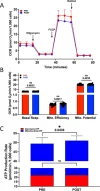Time-restricted eating improves quality of life, heart rate, and mitochondrial function in patients with postural orthostatic tachycardia syndrome. An open-label pilot study
Postural orthostatic tachycardia syndrome (POTS) is characterized by an abnormal increase in heart rate upon standing, leading to symptoms such as dizziness, fatigue, and rapid heart rate. Time-restricted eating (TRE), which limits caloric intake to an 8–10 h daily window, has been shown to decrease inflammation and improve immune, autonomic, and mitochondrial function, as well as cardiometabolic parameters.
This single arm pilot study evaluated the effects of TRE on quality of life (QOL), heart rate, and mitochondrial function in 20 participants with POTS (≥ 30 bpm increase in upright heart rate) and a baseline dietary window of ≥ 12 h. Following a 2-week baseline monitoring period, participants underwent a 12-week TRE intervention. Pre-and post-intervention assessments included QOL questionnaires, a 10-minute stand test, and plasma mitochondrial analysis.
TRE significantly reduced heart rate increase upon standing (mean decrease: 11 bpm, p < 0.001) and improved QOL metrics, as assessed by the Malmo POTS Symptom Score Survey (MAPS) and the General Health Questionnaire Short Form-36 (SF-36). Notable improvements include POTS symptom severity (p < 0.0001), physical functioning (p = 0.02), and energy/fatigue (p < 0.01). Additionally TRE increased mitochondrial-derived ATP production.
These findings suggest TRE as a promising lifestyle intervention to improve QOL, heart rate, and mitochondrial function in POTS patients.
Web | PDF | Nature Scientific Reports | Open Access
Dzotsi, Marissa; Strohm, Allyssa; Varshney, Shweta; Zuniga-Hertz, Juan P; Chitteti, Ramamurthy; Manoogian, Emily; Sethi, Anshika; Panda, Satchidananda; Patel, Hemal H; Doherty, Taylor A; Taub, Pam
Postural orthostatic tachycardia syndrome (POTS) is characterized by an abnormal increase in heart rate upon standing, leading to symptoms such as dizziness, fatigue, and rapid heart rate. Time-restricted eating (TRE), which limits caloric intake to an 8–10 h daily window, has been shown to decrease inflammation and improve immune, autonomic, and mitochondrial function, as well as cardiometabolic parameters.
This single arm pilot study evaluated the effects of TRE on quality of life (QOL), heart rate, and mitochondrial function in 20 participants with POTS (≥ 30 bpm increase in upright heart rate) and a baseline dietary window of ≥ 12 h. Following a 2-week baseline monitoring period, participants underwent a 12-week TRE intervention. Pre-and post-intervention assessments included QOL questionnaires, a 10-minute stand test, and plasma mitochondrial analysis.
TRE significantly reduced heart rate increase upon standing (mean decrease: 11 bpm, p < 0.001) and improved QOL metrics, as assessed by the Malmo POTS Symptom Score Survey (MAPS) and the General Health Questionnaire Short Form-36 (SF-36). Notable improvements include POTS symptom severity (p < 0.0001), physical functioning (p = 0.02), and energy/fatigue (p < 0.01). Additionally TRE increased mitochondrial-derived ATP production.
These findings suggest TRE as a promising lifestyle intervention to improve QOL, heart rate, and mitochondrial function in POTS patients.
Web | PDF | Nature Scientific Reports | Open Access

